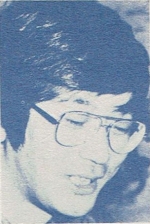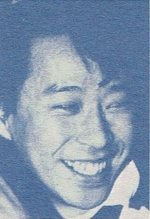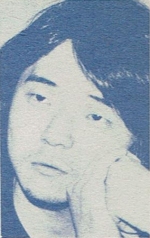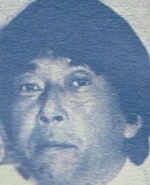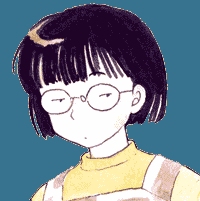

Animage Powerful Back Up
Conquering the anime world, a roundtable discussion for young directors! Let's go to battle!!
Translated by: Harley Acres
Oshii, Mashimo, Ueda, and Nishikubo can be called the "third generation of newcomers" in the anime production world, but it takes three years for peaches and eight years for persimmons as they say, with more than a little hard work before they were recognized as the best directors. [1] They must have been some interesting experiences to share. I asked then to tell me how they became directors, focusing on anecdotes from their training days before they became a rivals and competed for supremacy.
|
|
|
|
|
|
|
|
I took the entrance exam with no knowledge of anime.
Animage: Until now, I think the magazine Animage has featured fewer directors than animators. The directors who appeared were limited to people from the first generation of TV animation, such as Yoshiyuki Tomino-san and Isao Takahata-san, who were your seniors. [2] However, as Urusei Yatsura attracted the attention of fans as a work, and Oshii-san's directing sense became a hot topic, each of these young directors could be consider "The Big Four". Each are around 30 years old, who, in the eyes of their fans, are probably considered "old men". And they have finally begun to attract attention within the industry. That is why we have gathered together the Big Four young directors who are expected to be active in 1988. In case you are interested, they are all former classmates at Tatsunoko Productions.
Oshii: No, I joined the company about two years later than the others, although I was the oldest.
Nishikubo: Yes. The three of us (Nishikubo, Mashimo, and Ueda) took the Tatsunoko Pro exam when we graduated.
Animage: Does that mean that all four of you are Hiroshi Sasagawa-san's disciples? [3]
Nishikubo: Every year we would hold a gathering with Sasagawa-san, but I think it's been since that gathering last year that the four of us have been together...
Animage: I guess you still have relationships through work.
Mashimo: In a lot of different ways (laughs).
Oshii: I guess it's bad when you talk about it (laughs).
Nishikubo: It's a secret (laughs). I'm the only one who's open to that... (laughs).
Oshii: Only Nishikubo is free.
Animage: Huh? Mashimo-san is also free, right?
Mashimo: No, I'm an employee of Tatsunoko.
Nishikubo: I'm an elite employee (laughs). Are Ueda and Mashimo the bosses?
Oshii: I think they would be about the level of a section manager in a normal company...
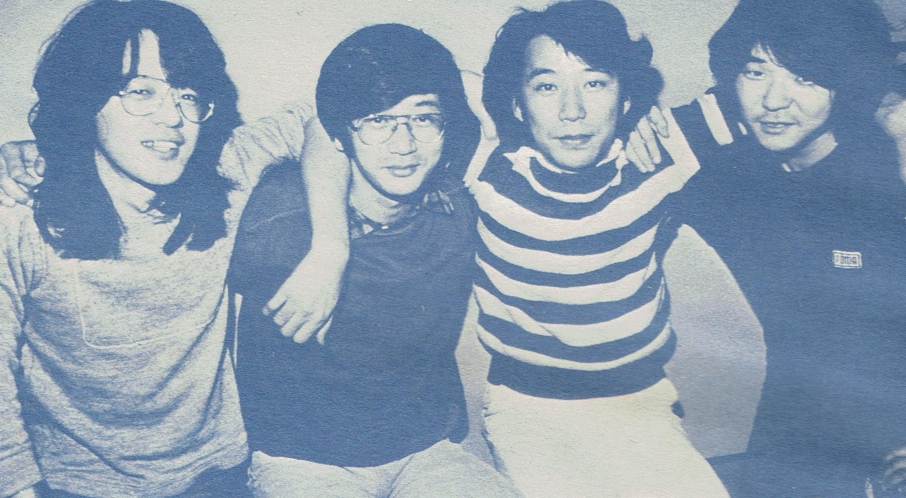
Nishikubo: In terms of magazines, I would be the deputy editor-in-chief (laughs).
Animage: (laughs) I see. Now that we've finished joking, I'd like to ask you a serious question: What was your motivation for joining Tatsunoko Pro?
Nishikubo: When I was taking the employment exam, I happened to live in Mitama (Western Tokyo, Hachioji, and Tachikawa), and when I opened the Mitama edition of the newspaper, there was an advertisement for a job with Tatsunoko. That's why I accepted.
Animage: Have you been interested in anime since your school days?
Nishikubo: No, not at all. I was a member of the Broadcasting Research Group and wanted to join a broadcasting station, but it was at a time when the media wasn't really recruiting...
Mashimo: Either way...
Nishikubo: Well, I couldn't get into it (laughs). Like, you have to have at least 30 good points to get in (laughs). So it was probably just a coincidence that I got into Tatsunoko.
Animage: You must have been interested in animation since your college days.
Nishikubo: I'm ashamed to say that I knew nothing about it. I thought the studio would be like a movie set, but I was surprised when I first went there. I wondered why they had to shoot from the top down on a film set (laughs).
Ueda: No, a lot of people didn't know much. I used to ask Mashimo if I had a question.
Mashimo: Even I didn't know.
Nishikubo: Mashimo worked in the film industry before, so he knew a lot about cameras. The Tatsunoko anime that I was familiar with were Space Ace (宇宙エース/Uchuu Ace), Speed Racer (マッハGOGOGO/Mach GoGoGo), and The Adventures of Hutch the Honeybee (昆虫物語 みなしごハッチ/Konchu Monogatari Minashigo Hacchi). I watched TV a few days before the exam, I was trying really hard (laughs).
Mashimo: I thought some series like Cashern (新造人間キャシャーン/Shinzo Ningen Cashern) were made in a foreign country (laughs).
Nishikubo: There are quite a lot of people who would come into the production without knowing anything (laughs). I don't know much about how it's done these days, but when I first said I wanted to be a producer, Sasakawa-san, who was the director of production at the time, said, "Well, why don't you come direct?"
Mashimo: Ah, that's what happened with me too. When I said I wanted to do the scenario, they told me to come direct, so I ended up directing.
Nishikubo: The same goes for Ueda. Didn't you say you wanted to draw manga?
Ueda: No, I said I wanted to make videos and draw pictures. So when I brought in the manuscript for the manga I had done, he said, "Oh, if you can draw this much, then you should direct it." But I had no idea about directing.
Animage: So you drew manga during your university days?
Ueda: That's right.
Animage: I heard you were working under someone...
Ueda: If I was working for a mangaka, I would have been dead by now (everyone laughs).
The director's first step begins with a phone number and a copy.
Animage: Oshii-san, you joined the company at a different time than the others.
Nishikubo: Why did you join Tatsunoko?
Oshii: Oh, I don't know. No, I quit my previous job without thinking about the future, so I was making plastic models every day. One day, as I was wandering around Kokubunji, I saw Tatsunoko right in front of me. I had some free time, and I used to watch a lot of TV, and around that time they were showing reruns of Gatchaman. It was so interesting that I remembered the name Tatsunoko from it. So, if I could make something like that, I thought I'd give it a try. So I called from the public pay phone in front of Kokubunji Station.
Animage: Is that why you joined?
Oshii: No, they were just recruiting. But I was told that the application deadline had been three days earlier (laughs), so I just submitted the application form. They had me start out in editing.
Mashimo: I started in editing too.
Oshii: So on the first day I went, Nunokawa-san was cutting together Yatterman (ヤッターマン). [4]
Nishikubo: The current "president"...
Oshii: So when I first saw an anime director, my first impression was that he was young, wearing cotton pants, a T-shirt, and sandals. He was dressed so sloppily. Directors were like that even back then (laughs).
Mashimo: That gave me confidence (laughs).
Oshii: Ah, I thought, "maybe I can do this too" (laughs).
Animage: So, that's why you joined Tatsunoko Pro. What was the first job you had to do?
Mashimo: Fetch phone numbers and get cups of tea (everyone laughs).
Animage: !?
Mashimo: Yeah, that's the truth.
Nishikubo: No, you should have said throwing out the trash in the morning (laughs). We'd carry the trash we collected the day before to the incinerator, hauling around lots of trash cans.
Oshii: That was the first thing they taught me. Tatsunoko's morning begins with throwing out the trash.
Nishikubo: Until Oshii-kun came in, we were still the new guys to the team, so we had been doing it for a long time.
Animage: So, after Nishikubo-san and his colleagues, they didn't hire any new recruits?
Nishikubo: Let's not beat around the bush, Oshii-kun's teacher was Mashimo-kun (laughs).
Oshii: Yes, it was Mashimo for a while. We were always stuck together.
Mashimo: One-on-one (laughs). They kept saying to me, "It's your fault that Oshii fails" (laughs).
Animage: What came next after "throwing away trash"?
Oshii: Making copies.
Nishikubo: Copy! (laughs).
Oshii: I was made to do the copying all the time, and after I had been doing it for about a month, Mashimo said to me, "That's enough copying!" As long as I was doing copying, I couldn't get any other jobs.
Nishikubo: It's like apprenticeship (laughs).
Animage: What was the first job you did as a director?
Nishikubo: The first video was one the three of us did. Walking, turning around, etc. They say it would be useful. I was forced to act like the main character of Tekkaman. Now that I think about it, I often did things that seemed difficult (laughs).
Ueda: "I'm going to do a video," he said, and he'd do retake after retake (laughs).
Oshii: I guess the process for me was different from you three. About two weeks after joining, I was asked to draw the storyboard that Sasagawa-san had created for practice.
Nishikubo: When I think about it now, I was really blessed. I was entrusted with a single storyboard even though I didn't know whether I could do it or not. Also, I was often asked to clean up other people's work. When I would copy Nunokawa-san's storyboards, his rough sketch was better than mine (laughs).
Animage: For example, I would play the role of a mentor who taught you how to draw storyboards...?
Mashimo: Sasagawa-san primarily.
Oshii: I asked Sasagawa-san to look at mine, but most often it was Mashimo.
Ueda: That's great. What a great guy (laugh).
Oshii: I used to correct the storyboards of Yatterman that were sent to an outsourcer. That was Mashimo's job for a long time, wasn't it?
Mashimo: Oh, that's right. You call out, "General assistant director, general assistant director."
Nishikubo: That's what we called the person who helps the general director with his work.
The differences between live-action fans and manga fans
Animage: What was each of your first productions?
Nishikubo: For me, it's The Song of Tentomushi (てんとう虫の歌/Tentou Mushi no Uta). Seitaro Hara and I each played did half. [5] I think it's was about five months after I joined.
Ueda: For me, Mashimo and I each did half the story on "Ten no Hagoromo" (天女の羽衣) from Time Bokan (タイムボカン). [6]
Mashimo: I think we did quite a bit as a duo.
Ueda: That's why Part A and Part B had different ideas and things they wanted to do, so they didn't connect well.
Nishikubo: The two of us were destined to be rivals (laughs).
Animage: What was Oshii-san's first work?
Oshii: I drew some of the storyboards for Yatterman, but I think Ippatsu Kanta-kun was the first where I was in charge of all the processing. [7]
Nishikubo: It is a common knowledge in the animation world that usually a director directs several episodes before they get to draw a storyboard, but I think it is quite rare for a director to start from the storyboarding stage.
Animage: On a different note, I heard that Oshii-san and Mashimo-san watch a lot of live-action movies...
Mashimo: Not so much for me. The most I saw on average was about 300 films a year. Oshii, did you say you watched about 1,000 films a year?
Nishikubo: That's an average of three a day!
Animage: So, have you been influenced by live-action direction in any way?
Mashimo: Recently, I have come to realize that some of the basic principles of live-action direction can be used in animation, but not the other way around. I feel that I used to do things very easily without making that distinction.
Animage: Is there a difference in direction between those who came into the industry because they like manga versus those who came into the industry because they like live-action?
Oshii: I feel like it becomes apparent eventually. For example, there are cases where people are drawn to movies because they've worked in manga, and vice versa, but there's a big difference between those people and people who were originally animators and then move on to direct. It's a matter of feeling, but it's a subjective issue, when it comes to how to convey it, I can't really put it in words.
Animage: Ueda-san, I think you came to anime because you like manga, but when you see Oshii-san and Mashimo-san's directing, do you feel any difference between theirs and your own?
Ueda: Of course there is. There are times when someone says to me, "No, that's a lie."
Animage: For example...
Ueda: The other day I watched "Shiver! Mystery in the Odd of Fossil Land," and it's amazing how it parodies a live-action documentary. I also thought that the way the hand-held camera was used in the episode was something I would have liked to try to do myself, and although the viewer may not feel it as much, I thought it was a lot of fun for the filmmakers.
Mashimo: I think anime is closer to the world of theatrical plays rather than live-action movies. There are things that happen behind the scenes that the audience can't see, and there are theatrical conventions. The viewer is convinced that it is just a fiction since it is depicted as a series of drawing, just as the viewer understands that they're watching a play without any explanation. I think these structures are similar. However, I don't think it would be very good for anime to try to create the realism of live-action, for example, the realism of Bruce Lee fighting.
The tension of repeating through trial and error is interesting.
Mashimo: By the way, there is something I wanted to ask Oshii-san myself regarding when you start a new series... Do you think there is a difference between working on an original work and an adaptation?
Oshii: To put it simply, it is hard to do an adaptation these days (laughs). People's image is totally different, they'll say it's miscast, and there is no way to do anything about it. Every week, I'd get a lot of complaints from people who are watching the show.
Mashimo: What?!?!?!
Oshii: Letters of protest, direct complaints, etc. There are quite a lot of cassettes that are sent in. I think anyone who is involved in directing can understand that the more you try to make changes based on such opinions, the more you end up not being able to meet those needs. It's not a creative situation... When NHK's director Tsutomu Wada was making a documentary about Hibari Misora, her mother told him, "Hibari has five million fans nationwide. I won't approve if you make a program that betrays her fans." However, according to Tsutomu Wada, "Five million is just a few percent of the overall audience that will watch the documentary." That kind of thing keeps flashing in my mind. [8] Maybe it's something I can say now, but I think I was able to convince Rumiko Takahashi fans, the manga fans. I spent a year and a half doing it without giving up. I guess I can say that now.
Mashimo: Simply put, we people in the field think that whether it is an original anime or an adaptation based on a manga, it's better to do anime in the straightforward manner of anime. Recently, however, I have a feeling that this may not be the case.
Oshii: However, as the first or second season progresses, the trend of the series becomes clear. Regarding original series versus adaptations I think that sometimes they come together as you work on them. Therefore, I can't betray the flow of the series myself. It's difficult to change that.
Animage: I think Urusei Yatsura is by far the funniest series, but if were to ask you why that is, what would you say?
Oshii: In the case of a series, there is a sense that the results are achieved week after week. The image changes rapidly through repeated trial and error with each episode. This is true even for a single character, and there is a kind of tension in the constant trial-and-error reaction. Also, in animation, you can't make a full-length film in two or three hours. I think that if you want to make a feature-length work, you have to make a series.
Animage: Well, what about the movie versions of Urusei?
Oshii: That's just one episode in a sense. The only difference is one is 20 minutes and the other is 80 minutes.
Animage: Do you feel like you have more freedom with TV?
Mashimo: I think there are some parts that are much more serious than in the theater. On the other hand, even if you are a 20-year-old director, you can challenge yourself to do what you want, which is different from the freedom you have, but you can also see that you have tried many things and failed. I guess that's sense of trial and error isn't allowed in theaters.
Oshii: In any case, I think it's most interesting to make a TV series in a situation where you have to put in the work. I think if you're free to do what you want and do it the way you want, it'll become more and more difficult. I guess the fact that it becomes so difficult is inherently interesting. I think the most fun thing about anime is that it has lots of fun moving around. There's something about the crowd scenes that I really want to do (laughs), and I can see that the number will increase and it'll be a lot harder to top the next week (laughs).
A Sharp Sense of Commonality
|
Of the four, I have known Mr. Oshii the longest. He has a sensitive side. Recently, "The Terror of Meow" was a masterpiece. It is a masterpiece of "new sensory direction by a young director. I again recognized his ability as a scriptwriter. What I hope for them from now on is that they do not become too maniacal. I would like them to aim for a major career that surpasses Kazuhiko Hasegawa. [11] |
Footnotes
- [1] "It takes three years for peaches and chestnuts and eight years for persimmons..." (桃栗3年柿8年/momo kuri san-nen, kaki hachi-nen) is a Japanese saying meaning that it takes three years for a peach or a chestnut to mature from a seed and a eight years for a persimmon, these cannot be rushed if you want to attain quality.
- [2] Yoshiyuki Tomino (富野由悠季) is best known for creating Mobile Suit Gundam (機動戦士ガンダム/Kido Senshi Gundam), Aura Battler Dunbine (聖戦士ダンバイン/Seisenshi Danbain) and Brave Raideen (勇者ライディーン/Yusha Raidiin) among many other Gundam related projects. Isao Takahata (高畑勲) was the co-founder of Studio Ghibli alongside Hayao Miyazaki (宮崎駿). Takahata directed Heidi, Girl of the Alps (アルプスの少女ハイジ/Arupusu no Shojo Haiji), Grave of the Fireflies (火垂るの墓/Hotaru no Haka), Only Yesterday (おもひでぽろぽろ/Omohide Poro Poro) and Pom Poko (平成狸合戦ぽんぽこ/Heisei Tanuki Gassen Ponpoko).
- [3] Hiroshi Sasagawa (笹川ひろし) directed anime such as Tokimeki Tonight (ときめきトゥナイト), Time Bokan (タイムボカン), Speed Racer (マッハ GoGoGo/Mach GoGoGo) and directed episodes of Voltron (百獣王ゴライオン/Hyakujuu-Ou GoLion) and Gatchaman (科学忍者隊ガッチャマン/Kagaku Ninja-Tai Gatchaman).
- [4] This would be Yuji Nunokawa (布川ゆうじ), the future head of Studio Pierrot.
- [5] Seitaro Hara (原征太郎) was the chief director on Pinocchio: The Series (樫の木モック/Kashi no Ki Mokku) and directed a number of episodes on Gatchaman II (科学忍者隊ガッチャマンII/Kagaku Ninja-Tai Gatchaman II). The Song of Tentomushi (てんとう虫の歌/Tentou Mushi no Uta) is a manga by Noboru Kawasaki (川崎のぼる) about seven orphan siblings. The anime ran from 1974 to 1976.
- [6] This is episode 50 of the 1975 anime Time Bokan (タイムボカン).
- [7] Ippatsu Kanta-kun (一発貫太くん) is the 1977-1978 baseball anime by Tatsunoko Pro.
- [8] Hibari Misora (美空ひばり) was a prolific singer, recording over 1,200 songs and appeared in many films each year. She was one of the most popular celebrities of the Showa era.
- [9] Tadashi Oka (総合) is a producer for Fuji Television. He got his start as an annoucer and then moved on to become a producer of anime such as Urusei Yatsura and Itadakiman (イタダキマン).
- [10] Kunihiko Yuyama (湯山邦彦) worked on the anime adaptations of Slow Step (スローステップ), Ushio and Tora (うしおととら) and Weather Report Girl (お天気お姉さん/Otenki Oneesan). Starting in 1997 he became the general director of Pokemon and has directed many of the films in that series.
- [11] Kazuhiko Hasegawa (長谷川和彦) is a director who got his start in Roman porno projects. He was lauded for his 1979 film The Man Who Stole the Sun (太陽を盗んだ男/Taiyo o Nusunda Otoko), which Kinema Junpo voted as the best Japanese film of the 1970s.

アニメージュ 1983年 1月
|

